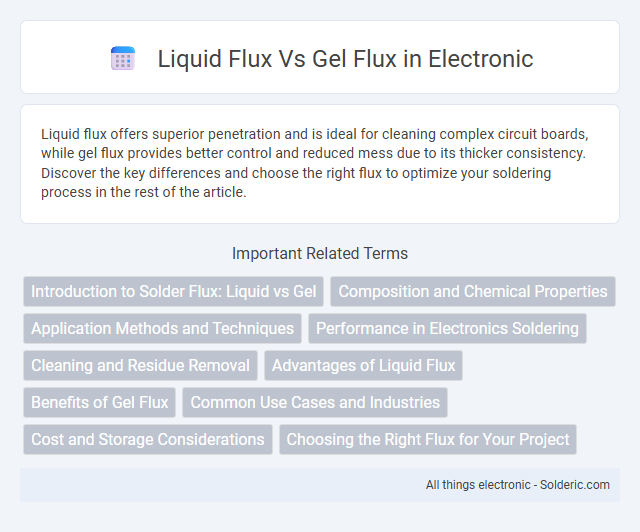Liquid flux offers superior penetration and is ideal for cleaning complex circuit boards, while gel flux provides better control and reduced mess due to its thicker consistency. Discover the key differences and choose the right flux to optimize your soldering process in the rest of the article.
Comparison Table
| Feature | Liquid Flux | Gel Flux |
|---|---|---|
| Consistency | Thin, fluid | Thick, viscous |
| Application | Easily spreads over surface | Localized application, less spread |
| Residue | May leave liquid residue | Typically minimal residue |
| Use Case | Ideal for cleaning and soldering large areas | Best for precision soldering and small components |
| Drying Time | Faster drying | Slower drying |
| Reactivity | Higher activity, quick activation | Controlled activity, gradual activation |
| Cleanliness | May require cleaning after use | Often no cleaning needed |
Introduction to Solder Flux: Liquid vs Gel
Liquid flux offers superior wetting action and easy application for electronic soldering, making it ideal for detailed circuit board work. Gel flux provides better control and reduced spillage due to its thicker consistency, suitable for larger components and through-hole soldering. Choosing between liquid and gel flux depends on the specific soldering task, component size, and precision requirements.
Composition and Chemical Properties
Liquid flux primarily consists of a mixture of activators such as rosin, organic acids, and solvents that enhance solderability by removing oxides and contaminants from metal surfaces. Gel flux contains similar chemical activators but is thickened with agents like fumed silica or polymers to provide a controlled, non-runny consistency, allowing precise application. Both flux types share reactive compounds designed to facilitate alloy formation and improve solder joint quality, but their distinct physical states influence their handling and effectiveness in various soldering contexts.
Application Methods and Techniques
Liquid flux is typically applied using brushes, needle applicators, or by dipping components, offering precise control for intricate soldering tasks and ensuring even coverage on small or delicate parts. Gel flux, thicker and more viscous, is often dispensed from syringes or cartridges, allowing for targeted application that prevents run-off and maintains placement on vertical or angled surfaces during soldering. Your choice between liquid and gel flux depends on the specific technique requirements and the complexity of the soldering job to achieve optimal joint quality.
Performance in Electronics Soldering
Liquid flux offers superior wetting capabilities and faster activation in electronics soldering, ensuring clean and reliable solder joints on intricate circuit boards. Gel flux provides better viscosity control, preventing excessive spread and improving precision in small or densely packed components. Your choice depends on the complexity of the task and the level of residue control needed for optimal soldering performance.
Cleaning and Residue Removal
Liquid flux offers superior cleaning properties due to its low viscosity, allowing it to penetrate tight spaces and effectively remove oxides and contaminants from surfaces. Gel flux, with its thicker consistency, tends to stay in place, reducing the risk of spreading but making residue removal more challenging without proper cleaning agents. Your choice between liquid and gel flux should consider the ease of residue removal to ensure optimal solder joint quality and reliability.
Advantages of Liquid Flux
Liquid flux offers superior wetting properties, ensuring better solder joint quality and reduced oxidation during the soldering process. It penetrates small and intricate areas more effectively than gel flux, which enhances heat transfer and leads to stronger, more reliable connections. Your soldering work benefits from easier application and cleaner residues that are simpler to remove, minimizing rework time and improving overall efficiency.
Benefits of Gel Flux
Gel flux offers precise application with minimal spread, reducing the risk of contamination on adjacent components during soldering. Its thicker consistency enhances stability, preventing dripping and ensuring consistent solder joint quality. Gel flux also improves visibility of the soldering area, enabling better control and accuracy for intricate electronic assemblies.
Common Use Cases and Industries
Liquid flux is widely used in electronics manufacturing for soldering printed circuit boards, offering precise application and excellent wetting properties ideal for fine-pitch components in consumer electronics and telecommunications. Gel flux is favored in plumbing, HVAC, and automotive industries due to its thicker consistency, which stays in place during soldering of copper pipes and metal fittings, preventing drips and ensuring strong, reliable joints. Both flux types are essential in metal joining processes but cater to distinct industrial needs, with liquid flux excelling in electronic assembly and gel flux dominating metalwork in construction and mechanical repairs.
Cost and Storage Considerations
Liquid flux generally costs less than gel flux due to simpler packaging and lower formulation complexity, making it budget-friendly for large-scale or frequent solders. Gel flux requires more careful storage because it can dry out or become viscous over time, potentially reducing effectiveness. Your choice hinges on balancing upfront costs with storage capabilities for optimal soldering performance.
Choosing the Right Flux for Your Project
Choosing the right flux for your project depends on the type of soldering and materials involved; liquid flux offers excellent penetration and is ideal for precise electronic work, while gel flux provides better control and is less likely to drip, making it suitable for vertical or complex joints. Liquid flux typically dries faster and can be easier to clean, whereas gel flux stays in place longer, ensuring thorough soldering without mess. Understanding these differences helps you optimize soldering quality and efficiency for your specific application.
Liquid flux vs gel flux Infographic

 solderic.com
solderic.com